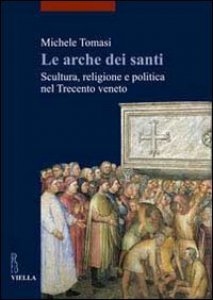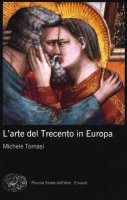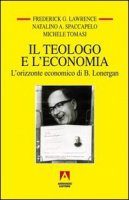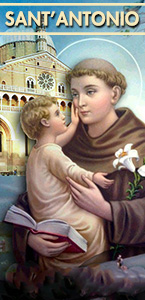Le arche dei santi. Scultura, religione e politica nel Trecento veneto
(I libri di Viella. Arte)EAN 9788883347252
Michele Tomasi’s fine book, a study of Trecento Saints’ tombs in the ‘‘Veneto’’focuses on an area that comprises the modern-day Veneto, Friuli-Venezia-Giulia,Romagna and the Istrian and Dalmatian coast. For a book concerned as much withpolitics as sculpture, this may seem an odd amalgamation of regions, but the rationale stems both from the author’s starting point, Wolfgang Wolters’ La scultura veneziana gotica (1300-1460) of 1976, and from the concentration of saints’ tombs inthe region. Tomasi identifies twenty-two monuments of saints and traces the crucialrole played by these figures, their bodies and their tombs within fourteenth-centuryVenetan society. Each monument is illustrated profusely, with many appearing incolour for the first time, and each is described and discussed in an appendix of sixtypages.
This appendix or corpus makes no pretense at being a catalogue raisonne´ but,alongside Wolters, will become an essential starting point for future studies. Six thematic chapters precede the corpus and alert readers to lost or transformed tombs,demonstrate how sanctity could be rendered visible and tangible through structuraldevices, consider patrons and their intentions, unravel messages on the monumentsthemselves, present wider contexts such as inscriptions or associated reliquaries,and finally investigate the artists, workshops and styles. Thus it is an interdisciplinary analysis of the late medieval cult of saints in northeast Italy and their tombs,which were primarily carved but not exclusively so, and with some attention paidto devotional objects associated with twenty saints or blesseds. The value of such acultural history of saints is that it enables one to study the multifarious aspects ofartistic production, patronage and iconography, and consider the collaborative orindividual roles of civic institutions and rulers, ecclesiastics and their institutions(not forgetting the new mendicant orders).
The first chapter looks at monuments that are either lost or transformed and attempt a reconstruction using all documents available for investigation, from earlyguide books to pastoral visits and visual evidence. Aside from serving as a primerfor graduate students it should remove once and for all the view that the fourteenth-century tomb of St Luke in Padua’s church of Santa Giustina is a later construct.Chapter 2 is a through cultural history of sanctity beyond death and its impacton the development of tomb monuments. It usefully situates Veneto tombs in theirwider European context and the tradition which records extant tombs on columnsfrom the twelfth century. It explains the elevation of the saint, from the interior ofaltars to separate containers and the opportunities for renewal of the saint for bothpragmatic and devotional reasons and the rationale behind such display. It offerscomparisons with wall hung saints’ tombs of Tuscany and reminds the reader thatsome Veneto tombs were also, exceptionally, hung that way, namely those of St Isidore at San Marco and Blessed Bartolomeo da Breganze in Vicenza. It challengesthe importance of the tomb of Dominic as a model for St Antony of Padua’s tomband argues for the pre-eminence of the latter for subsequent tombs in the region.The importance of its polychrome marble, in particular, is well articulated and convincing.The third and longest chapter is on patronage and takes the form of selectedcase studies of patriarchal, civic, and ecclesiastical commissions, including the Benedictine and Mendicant orders. It begins with the input of Bishop Bertrand of SaintGenie`s of Aquileia into the tomb of Saints Ermagora and Fortunatus.
There is a fullaccount of what we know of his life and wider artistic patronage. Although the discussion of the tomb itself is rather buried and largely a synthesis of the recent workof others, the chapter is useful as an illustration of the common political motivationbehind the relaunch of saints and in particular how contested claims over relicscould be resolved by commissioning a new saint’s tomb asserting authenticity visually (in this case over the rival tombs of opponents Grado, supported by Venice,and Aquileia). The author’s new insights on the subject are valuable but some readers may find it frustrating to have to skip to the Corpus for an account of the chronology of the tomb, despite having trawled through seventeen pages of text. Indeed,the author’s dissection of what are essentially eight substantial case studies into thematic chunks requiring the reader constantly to shift from chapter to corpus andfrom one chapter to another (from patronage to iconography, for example, or fromimage to inscription), is occasionally a hindrance.
It leads to unnecessary repetitionand inconsistencies of treatment, as when one inscription is included in the chapteritself but another is banished to the corpus. Thankfully there is an index of namesand places though unfortunately not of concepts but the book’s organisation mayprove to be too un-user-friendly for some.Not to be missed are Tomasi’s suggestions that in addition to the bishops, whohave tended to be side-lined as patrons after 1200, one should look most closely atthe role of parish priests in some commissions. Some cities, meanwhile, had different styles of government and administration and the author rightly observes thatthe Procurators of San Marco in Venice had probably more to do with for the commission of the tomb and chapel of St Isidore than Doge Andrea Dandolo.Not all Tomasi’s visual observations are as convincing. One concerns the tombof the Franciscan blessed Odoric of Pordenone in Udine. According to the author,its commission involved the friars, the commune, and the patriarch of Aquileiaand he closely adheres to Tilatti’s view that the friars were major players. In my opinion however, Miotto was more convincing in identifying as a non-Franciscan thefirst of six non-angelic figures who hold Odoric’s shroud on one of the long sidesof his tomb of 1331-2.
Whilst we cannot say for sure that he is the camerarius ofUdine, he is certainly not wearing a Franciscan habit even though he appears to betonsured and wears a cloak of office similar to those worn by treasurers on the Biccherne of Siena. Unlike the three friars on his left, his garment has no hood. This detail may seem an unimportant corrective if it weren’t for the fact that Tomasi’s claimfor pre-eminent Franciscan intervention hinges on this identification.Notwithstanding these criticisms this is a book that deserves to be read and occupy a central place in studies of saints’ cults and their tomb monuments during themiddle ages.
Tratto dalla Rivista "Il Santo. Rivista francescana di storia dottrina arte" LII, 2012, fasc. 3
(http://www.centrostudiantoniani.it)






























